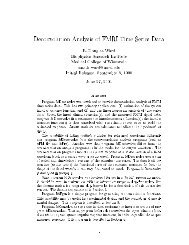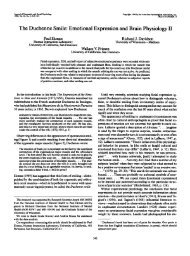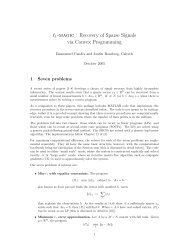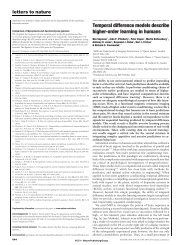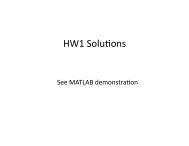Neural correlates of attentional expertise in long-term meditation ...
Neural correlates of attentional expertise in long-term meditation ...
Neural correlates of attentional expertise in long-term meditation ...
You also want an ePaper? Increase the reach of your titles
YUMPU automatically turns print PDFs into web optimized ePapers that Google loves.
anxiety, or depression (44). Thus, our data encourage the exam<strong>in</strong>ation<br />
<strong>of</strong> <strong>meditation</strong> as a potential form <strong>of</strong> <strong>attentional</strong> tra<strong>in</strong><strong>in</strong>g <strong>in</strong><br />
both disordered and normal populations and may provide an<br />
answer to William James’s question posed 100 years ago when he<br />
asked how we might educate attention because such education<br />
would be ‘‘the education par excellence’’ (orig<strong>in</strong>al italics; ref. 45).<br />
Methods<br />
Participants. Participants <strong>in</strong>cluded 14 <strong>long</strong>-<strong>term</strong> Buddhist practitioners<br />
whom we classified as EMs (mean age 46.8 years, ages 29–64<br />
years, SD 12.1 years), 16 age-matched healthy NMs (mean age <br />
46.6 years, ages 23–56 years, SD 10.8 years), and 11 INMs who were<br />
told they would receive a $50 bonus if among the top one-third <strong>in</strong><br />
activat<strong>in</strong>g attention-related regions (mean age 39 years, ages<br />
31–51 years, SD 7.1 years). (For more details, see SI Methods.) One<br />
week before the actual functional MRI scan session, NMs were<br />
given written <strong>in</strong>structions on how to perform the <strong>meditation</strong><br />
practices, written by M. Ricard, and practiced concentration and<br />
two other <strong>meditation</strong>s for 1 h per day for 1 week, 20 m<strong>in</strong> per<br />
<strong>meditation</strong> (also see SI Methods).<br />
Task and Protocol. The technical <strong>term</strong> for this <strong>meditation</strong> <strong>in</strong> Tibetan<br />
literally means one-po<strong>in</strong>ted concentration. As described <strong>in</strong> M.<br />
Ricard’s <strong>in</strong>structions for the NMs: ‘‘this is a state <strong>in</strong> which one tries<br />
to focus all one’s attention on one object, keep it on that object, and<br />
br<strong>in</strong>g it back to that object when one f<strong>in</strong>ds that one has been<br />
distracted (by outer perceptions or <strong>in</strong>ner thoughts).’’ Two <strong>in</strong>correct<br />
tendencies would be s<strong>in</strong>k<strong>in</strong>g <strong>in</strong>to dullness or sleep<strong>in</strong>ess, or be<strong>in</strong>g<br />
carried away by mental agitation and <strong>in</strong>ternal thought ‘‘chatter.’’ All<br />
NMs were <strong>in</strong>formed <strong>of</strong> these tendencies and <strong>in</strong>structed to simply<br />
return to the object <strong>of</strong> <strong>meditation</strong> with a sense <strong>of</strong> sharp focus. The<br />
technical <strong>term</strong> for the Rest state was, <strong>in</strong> Tibetan, neutral m<strong>in</strong>d, <strong>in</strong><br />
which the eyes rema<strong>in</strong>ed open and fixated. In the <strong>in</strong>structions for<br />
NMs, the neutral state was expla<strong>in</strong>ed as one <strong>in</strong> which ‘‘your<br />
emotional state is neither pleasant nor unpleasant and that you<br />
rema<strong>in</strong> relaxed. Try to be <strong>in</strong> the most ord<strong>in</strong>ary state without be<strong>in</strong>g<br />
engaged <strong>in</strong>to an active mental state (like voluntarily remember<strong>in</strong>g<br />
or plann<strong>in</strong>g someth<strong>in</strong>g or actively look<strong>in</strong>g at an object).’’<br />
We used a block design with blocks <strong>of</strong> vary<strong>in</strong>g length (more ideal<br />
for deconvolution analysis), alternat<strong>in</strong>g an average <strong>of</strong> 2.7 m<strong>in</strong> (range<br />
146–170 sec) <strong>of</strong> the state <strong>of</strong> <strong>meditation</strong> (object <strong>of</strong> <strong>meditation</strong> was<br />
a small dot on a gray screen) with an average <strong>of</strong> 1.6 m<strong>in</strong> (range<br />
84–106 sec) <strong>of</strong> Rest (four cycles plus one extra 128-sec Rest state <strong>of</strong><br />
20 m<strong>in</strong>). A total <strong>of</strong> 25 2-sec auditory sounds from the International<br />
Affective Digitized Sounds (46) were presented <strong>in</strong> random<br />
order for each valence (positive, neutral, and negative). These<br />
sounds were presented every 6–10 sec after the first 40 sec <strong>of</strong> the<br />
meditative blocks and after 15 sec <strong>of</strong> the rest<strong>in</strong>g blocks. Null trials<br />
(silent events) were randomly presented between the auditory<br />
stimuli (47, 48). Participants were <strong>in</strong>structed to ma<strong>in</strong>ta<strong>in</strong> their<br />
practice dur<strong>in</strong>g the presentation <strong>of</strong> the sounds.<br />
Standard data collection and analysis process<strong>in</strong>g procedures were<br />
followed and are described <strong>in</strong> SI Methods.<br />
We thank Dr. Matthieu Ricard for assistance with task design, participant<br />
recruitment, and written <strong>meditation</strong> <strong>in</strong>structions; Dr. Larry Greischar for<br />
assistance with pupil diameter assessment; Dr. Tom Johnstone and Dr.<br />
Doug Ward with process<strong>in</strong>g assistance; Dr. Rob<strong>in</strong> Kornman for help with<br />
results <strong>in</strong>terpretation; Dr. John Dunne for Tibetan translation; Drs. James<br />
Lewis and A<strong>in</strong>a Puce for review<strong>in</strong>g earlier versions <strong>of</strong> the manuscript;<br />
undergraduate students A. Francis, W. A. Phillips, A. Shah, S. Harkness,<br />
and S. P. Simhan for assistance <strong>in</strong> data collection and data process<strong>in</strong>g; and<br />
the M<strong>in</strong>d and Life Institute for help <strong>in</strong> recruit<strong>in</strong>g practitioners and lay<strong>in</strong>g the<br />
foundation for this work. Support was provided by National Institute <strong>of</strong><br />
Mental Health Grant P50-MH069315 (to R.J.D.), National Center for<br />
Complementary and Alternative Medic<strong>in</strong>e Grant U01AT002114-01A1 (to<br />
A.L.), and gifts from Adrianne and Edw<strong>in</strong> Cook-Ryder, Bryant Wangard,<br />
Keith and Arlene Bronste<strong>in</strong>, and the John W. Kluge Foundation.<br />
1. Lutz A, Dunne JD, Davidson RJ (2007) <strong>in</strong> The Cambridge Handbook <strong>of</strong> Consciousness,<br />
eds Zelazo PD, Moscovitch M, Thompson E (Cambridge Univ Press, Cambridge,<br />
UK).<br />
2. Kyabgon T (2003) The Benevolent M<strong>in</strong>d, A Manual <strong>in</strong> M<strong>in</strong>d Tra<strong>in</strong><strong>in</strong>g (Zhyisil Chokyi<br />
Gyatsal Trust, Auckland, New Zealand).<br />
3. Mipham SJ (2000) 1999 Sem<strong>in</strong>ary Transcripts, Teach<strong>in</strong>g from the Sutra Tradition<br />
(Vajradhatu, Nova Scotia, Canada).<br />
4. Jha A, Kle<strong>in</strong> R, Kromp<strong>in</strong>ger J, Baime M (2007) Cogn Affect Behav Neurosci<br />
7:109–119.<br />
5. Slagter HA, Lutz A, Greischar LL, Francis AD, Nieuwenhuis S, Davis JM, Davidson<br />
RJ (2007) PLoS Biol 5:e138.<br />
6. Carter OL, Presti DE, Callistemon C, Ungerer Y, Liu GB, Pettigrew JD (2005) Curr<br />
Biol 15:R412–R413.<br />
7. Lutz A, Greischar LL, Rawl<strong>in</strong>gs NB, Ricard M, Davidson RJ (2004) Proc Natl Acad<br />
Sci USA 101:16369–16373.<br />
8. Lazar SW, Kerr CE, Wasserman RH, Gray JR, Greve DN, Treadway MT, McGarvey<br />
M, Qu<strong>in</strong>n BT, Dusek JA, Benson H, et al. (2005) NeuroReport 16:1893–1897.<br />
9. Moore CD, Cohen MX, Ranganath C (2006) J Neurosci 26:11187–11196.<br />
10. Seung Y, Kyong JS, Woo SH, Lee BT, Lee KM (2005) Neurosci Res 52:323–329.<br />
11. Ross JS, Tkach J, Ruggieri PM, Lieber M, Lapresto E (2003) Am J Neuroradiol<br />
24:1036–1044.<br />
12. Sakai KL (2005) Science 310:815–819.<br />
13. Doyon J, Song AW, Karni A, Lalonde F, Adams MM, Ungerleider LG (2002) Proc<br />
Natl Acad Sci USA 99:1017–1022.<br />
14. Corbetta M, Akbudak E, Conturo TE, Snyder AZ, Oll<strong>in</strong>ger JM, Drury HA,<br />
L<strong>in</strong>enweber MR, Petersen SE, Raichle ME, Van Essen DC, Shulman GL (1998)<br />
Neuron 21:761–773.<br />
15. Mesulam MM (1981) Ann Neurol 10:309–325.<br />
16. Lawrence NS, Ross TJ, H<strong>of</strong>fmann R, Garavan H, Ste<strong>in</strong> EA (2003) J Cognit Neurosci<br />
15:1028–1038.<br />
17. Wager TD, Smith EE (2003) Cogn Affect Behav Neurosci 3:255–274.<br />
18. B<strong>in</strong>der JR, Frost JA, Hammeke TA, Bellgowan PSF, Rao SM, Cox RW (1999) J<br />
Cognit Neurosci 11:80–95.<br />
19. Mason MF, Norton MI, Van Horn JD, Wegner DM, Grafton ST, Macrae CN (2007)<br />
Science 315:393–395.<br />
20. Nitschke JB, Sar<strong>in</strong>opoulos I, Mackiewicz KL, Schaefer HS, Davidson RJ (2006)<br />
NeuroImage 29:106–116.<br />
21. Van Essen DC, Lewis JW, Drury HA, Hadjikhani N, Tootell RBH, Bakircioglu M,<br />
Miller MI (2001) Vision Res 41:1359–1378.<br />
22. Schulz KP, Fan J, Tang CY, Newcorn JH, Buchsbaum MS, Cheung AM, Halper<strong>in</strong><br />
JM (2004) Am J Psychiatry 161:1650–1657.<br />
23. Oakes TR, Fox AS, Johnstone T, Chung MK, Kal<strong>in</strong> N, Davidson RJ (2007)<br />
NeuroImage 34:500–508.<br />
24. Wager TD, Jonides J, Read<strong>in</strong>g S (2004) NeuroImage 22:1679–1693.<br />
25. Raichle ME, MacLeod AM, Snyder AZ, Powers WJ, Gusnard DA, Shulman GL<br />
(2001) Proc Natl Acad Sci USA 98:676–682.<br />
26. Brefczynski JA, DeYoe EA (1999) Nat Neurosci 2:370–374.<br />
27. Gusnard DA, Akbudak E, Shulman GL, Raichle ME (2001) Proc Natl Acad Sci USA<br />
98:4259–4264.<br />
28. Hunter MD, Eickh<strong>of</strong>f SB, Miller TW, Farrow TF, Wilk<strong>in</strong>son ID, Woodruff PW<br />
(2006) Proc Natl Acad Sci USA 103:189–194.<br />
29. Fernandez-Duque D, Baird JA, Posner MI (2000) Conscious Cogn 9:288–307.<br />
30. Critchley HD, Wiens S, Rotshte<strong>in</strong> P, Ohman A, Dolan RJ (2004) Nat Neurosci<br />
7:189–195.<br />
31. Corbetta M, Shulman GL (2002) Nat Rev Neurosci 3:201–215.<br />
32. Casey BJ, Castellanos FX, Giedd JN, Marsh WL, Hamburger SD, Schubert AB,<br />
Vauss YC, Vaituzis AC, Dickste<strong>in</strong> DP, Sarfatti SE, Rapoport JL (1997) J Am Acad<br />
Child Adolesc Psychiatry 36:374–383.<br />
33. Aron A, Poldrack RA (2006) J Neurosci 26:2424–2433.<br />
34. Anderson MC, Ochsner KN, Kuhl B, Cooper J, Robertson E, Gabrieli SW, Glover<br />
GH, Gabrieli JD (2004) Science 303:232–235.<br />
35. Ochsner KN, Bunge SA, Gross JJ, Gabrieli JD (2002) J Cognit Neurosci 14:1215–1229.<br />
36. Urry HL, van Reekum CM, Johnstone T, Kal<strong>in</strong> NH, Thurow ME, Schaefer HS,<br />
Jackson CA, Frye CJ, Greischar LL, Alexander AL, Davidson RJ (2006) J Neurosci<br />
26:4415–4425.<br />
37. Lev<strong>in</strong> JM, Frederick BB, Ross MH, Fox JF, von Rosenberg HL, Kaufman MJ, Lange<br />
N, Mendelson JH, Cohen BM, Renshaw PF (2001) Magn Reson Imag<strong>in</strong>g 19:1055–<br />
1062.<br />
38. Huettel SA, S<strong>in</strong>german JD, McCarthy G (2001) NeuroImage 13:161–175.<br />
39. Townsend J, Adamo M, Haist F (2006) NeuroImage 31:1682–1692.<br />
40. Booth JR, Burman DD, Meyer JR, Lei Z, Trommer BL, Davenport ND, Li W, Parrish<br />
TB, Gitelman DR, Mesulam MM (2005) J Child Psychol Psychiatry 46:94–111.<br />
41. Vaidya CJ, Bunge SA, Dudukovic NM, Zalecki CA, Elliott GR, Gabrieli JD (2005)<br />
Am J Psychiatry 162:1605–1613.<br />
42. Rubia K, Smith AB, Brammer MJ, Toone B, Taylor E (2005) Am J Psychiatry<br />
162:1067–1075.<br />
43. Hill DE, Yeo RA, Campbell RA, HartB, Vigil J, Brooks W (2003) Neuropsychology<br />
17:496–506.<br />
44. Watk<strong>in</strong>s E, Teasdale JD (2004) J Affect Disord 82:1–8.<br />
45. James W (1890) The Pr<strong>in</strong>ciples <strong>of</strong> Psychology (Classics <strong>of</strong> Psychiatry and Behavioral<br />
Sciences Library, Birm<strong>in</strong>gham, UK).<br />
46. Bradley MM, Lang PJ (2000) Psychophysiology 37:204–215.<br />
47. Buckner RL (1998) Hum Bra<strong>in</strong> Mapp 6:373–377.<br />
48. Dale AM (1999) Hum Bra<strong>in</strong> Mapp 8:109–114.<br />
11488 www.pnas.orgcgidoi10.1073pnas.0606552104 Brefczynski-Lewis et al.


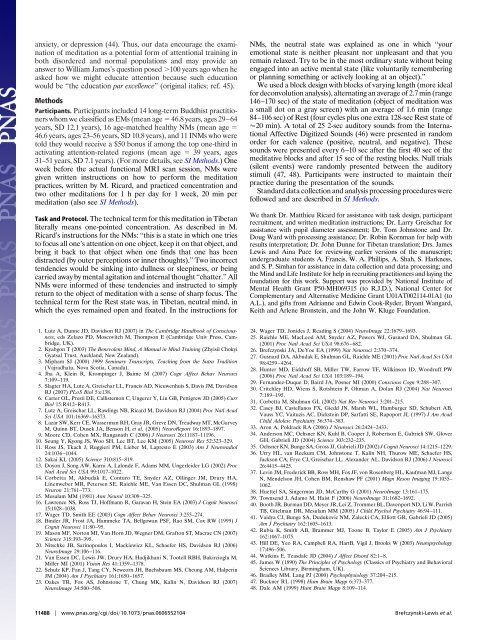
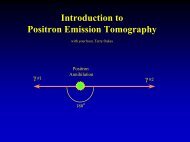
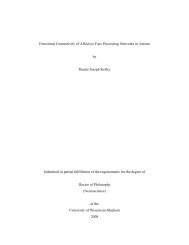
![[F-18]-L-DOPA PET scan shows loss of dopaminergic neurons](https://img.yumpu.com/41721684/1/190x146/f-18-l-dopa-pet-scan-shows-loss-of-dopaminergic-neurons.jpg?quality=85)
